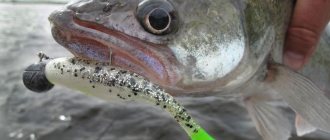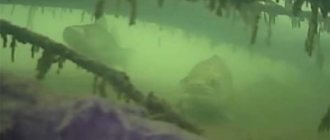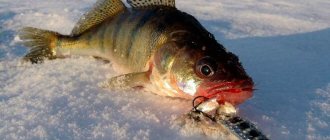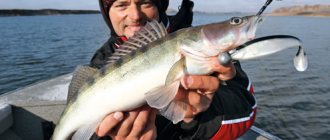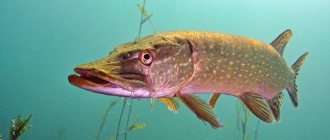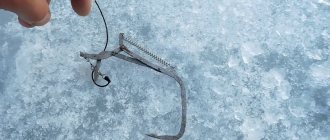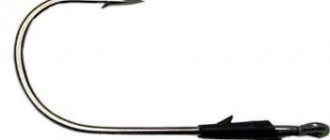Pike perch is a relative of perch. The peculiarity of the fish is that it prefers exceptionally clean reservoirs, which are filled with sufficient oxygen to ensure the best living conditions.
This point means that pike perch is quite popular; when catching this prey, you can be sure that there are no excess phosphates and other impurities in the composition. It is known that many rivers and lakes are saturated with harmful substances that can accumulate in fish. Pike perch is a very fastidious predator.
Often an individual about 30 cm long is caught on the hook, but there are specimens weighing 20 kg or more. The structural features of the fish determine that even large specimens do not accumulate fat. That is why pike perch is considered white and lean meat; it has its own unique taste and contains a large amount of protein.
In addition to protein, the composition also includes chromium, sulfur, fluorine, potassium, iodine, phosphorus and vitamin PP. This desirable predator can be caught all year round, which also determines its popularity among anglers.
Description and behavior characteristics
Many previously believed that the freshwater predator in question originally began to be found in Europe, and only a few decades ago became part of the freshwater bodies of North America. Now the fish is found in water bodies all over the world.
Recent genetic studies of the DNA of the ancestors of the species in question indicate that they appeared on the European continent approximately 3-4 million years ago. An interesting fact is that over such a long period the fish has not changed, as evidenced by the found fossils.
The features of the considered inhabitant of fresh water bodies include:
- It is large in size, which also explains its high popularity among fishermen.
- Official data determines that a large individual can reach a length of more than a meter and a weight of up to 15 kg. According to unofficial data, the weight of the largest individuals reaches 20 kg.
- Prefers fresh water bodies, most often found in Asia and Europe, in the rivers of the Caspian, Aral, Azov and Black Seas.
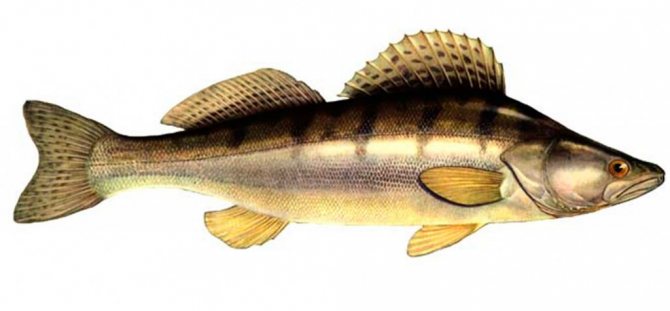
Pike perch
There are large teeth on the jaw that resemble fangs. Moreover, in males, as a rule, they are larger than in females.- The lifestyle corresponds to all predatory fish that live in freshwater.
- Large individuals prefer fry, and small ones prefer invertebrates.
- It is not found in dirty and swampy bodies of water, as it is very sensitive to the amount of oxygen in the water.
- In warm weather it maintains a depth of about 5 meters.
- High activity is observed during the day and at night. In the dark, it prefers shallow water; in daylight, it likes to stay in the depths.
- The bottom with various snags and stones of sandy and pebble type is the habitat of the fish in question. This behavioral feature is due to the fact that pike perch is a predatory fish and likes to hide during the hunt.
As a rule, the predator attacks bleaks, gobies, minnows and sprat. This is due to the fact that such bait is small, and pike perch has a naturally narrow throat. Therefore, fishing with a bait with a wide body may not lead to the expected result.
Choosing a location and gear
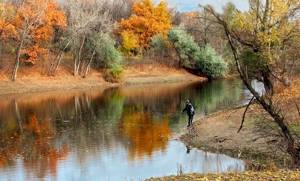
Spring
When the water warms up to a temperature of +10-+15°C, the spawning period of pike perch begins. It is characterized by the fact that pike perch begins to look for well-warmed places with an uneven bottom, where they lay eggs. After completing this process, he goes to rest and remains inactive for about 2 weeks. After this, being very hungry, the pike perch begins to actively feed, moving from one place to another.
During this period, pike perch can be caught using any gear designed for catching predators. It is actively caught both from the shore and from the boat, actively attacking various baits, including live bait. This period does not last long, after which its activity decreases and it goes deeper. During this period, he hunts only in the dark. Its measured life begins somewhere in early June, and it begins to spawn in mid-April or early May. It all depends on natural conditions and how quickly the water warms up.
Summer
Starting in June, pike perch are caught using spinning rods or other bottom gear. It should be remembered that he hunts mainly at dusk. Therefore, the best periods for catching it will be early morning or late evening, including night. To catch pike perch, like catfish, bottom gear is installed in the late evening with various baits, including live bait. Early in the morning you can hunt pike perch with a spinning rod using various silicone baits.
Autumn
Before the beginning of autumn, when the water temperature begins to gradually decrease, the pike perch becomes active again, but does not leave the depths. During this period, you can get it using a jig head or spoon. But even at this time, he does not swim past the live bait without swallowing it. The peak of its activity occurs in October-November, right before the first ice appears.
Winter
In winter, it is less active, but continues to feed. From the ice it can be caught using a balance beam or other baits. At the same time, it is always at depth and only occasionally rises into the water column in search of a potential victim. This can occur during periods of winter warming. If you carefully study the nature of the reservoir, you can easily “calculate” its location. Having caught one pike perch, you can count on a good catch, since pike perch travel in a flock.
Habitats
Small low-flow reservoirs, which can be called a favorite fishing spot for many, are not the habitat of a large freshwater predator.
When considering habitat, the following points should be considered:
- A deep river that runs through mid-latitudes can be called an ideal habitat for this fish.
- The current should be moderate, the bottom topography is complex. Difficult terrain allows you to find a place where you can hide for hunting.
- The water should be relatively warm to provide the right amount of prey. The current determines a good oxygen regime, which determines the development of production.
- Exits from channel holes can also be called a place where you can secure an excellent catch. However, the current must be significant.
- The area near channel dumps, deep-sea “trunks” with a relief of heterogeneous structure.
When analyzing the above recommendations, it can be noted that the most suitable area for fishing is a deep, warm river with a sufficiently large depth, a heterogeneous bottom structure and a high current, but the water must be clean.
An exception to the above recommendations is fishing at night . With the onset of darkness, pike perch are found in shallow coastal waters. If there are no such areas on the river, then the fish simply go to shallower depths.
Catching pike perch on a feeder
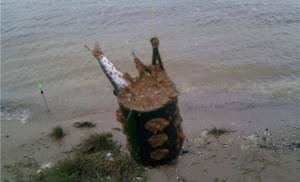
An alternative option for bottom gear is a feeder. The feeder rod is mainly equipped with three tips, which allows the rod to be used in various fishing conditions. When fishing in the current, use a hard tip, since you will have to throw a load weighing from 80 to 100 g, or even heavier. If pike perch fishing is carried out in an open place where there are no special obstacles, then a sliding weight can be installed on the tackle, and if there are various obstacles at depth, the weight is attached to a separate leash. Basically, narrow and long sinkers are used. The reel size most suitable for fishing is in the range of 3000-5000. The reel must have a friction brake, which will have to be well adjusted. When a pike perch bites, the reel should begin to release the line if it catches a large specimen.
Some fishermen use a steel leash, others do not. There is a category of fishermen who do not even install such leashes on pike, believing that they scare the attacking fish.
When fishing for pike perch, you can use a feeder, which contains bait for peaceful fish. It attracts small individuals, and they, in turn, attract a predator. We can recommend the following bait: breadcrumbs are mixed from crushed fish. You can use store-bought sprat or capelin as fish.
The duration between casts can reach 20-25 minutes. After casting, the rod is positioned so that the bait fish can rise from the bottom and remain in the water column.
Fishing calendar by season
Already quite a long time ago, calendars for the season of the most successful conditions for fishing were created. They should be considered for each area separately; the bite may depend on weather conditions.
The biting calendar in this case is as follows:
- In January, fish will move quite actively around the reservoir in search of prey, which is becoming scarcer due to the cold weather.
- In February , if there is a thaw or frosts have decreased at the time of snowfall, the fish will begin to bite well.
- In the first half of March, the bite will depend on the weather; in the second half, as a rule, it will become easier to find prey.
- April can be called an excellent time, as the thaw leads to the filling of the reservoir with prey.
In the first half of May there is a possibility of pre-spawning movement of fish; in the second half of the month it is recommended to choose the period after spawning.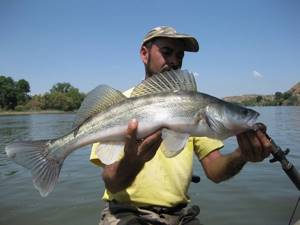
- In June, the desired inhabitant of the reservoir is well caught in shallow water, where there is a large amount of small prey.
- In July, the zander's appetite subsides.
- In the first half, the bite may decrease due to the intense heat. If in the second half of the month the temperature stabilizes, then the fish begin to catch more actively.
- With the onset of September, the fish leave their summer habitat and go to deeper sections of the river.
- If the cold weather begins in October, then pike perch takes well. The fish begin to feed more actively on the eve of cold weather.
- In November the cold weather begins. After the active period, the fish begins to behave inhibited, and the chances of being caught become less and less.
- In December, you have a chance to find fish only if you find a hole with difficult terrain at the bottom.
The above features should be taken into account when planning pike perch fishing throughout the year.
Features of choosing live bait for catching pike perch
The predatory fish in question is often compared to a tiger. The behavior of pike perch is determined by the fact that it attacks its prey at night, jumping out from an ambush with lightning speed. At the same time, like a real predator, it does not feed on carrion. The above points determine that when choosing bait, preference should be given to live and active bait. A dead bait will not interest a predator.
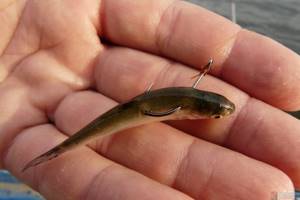
Features of choosing live bait include:
- Preference should be given to fish that live in the same body of water.
- Classic bait can be called crucian carp, bleak, roach fry, and perch.
- The size of live bait, as a rule, should not exceed 12 centimeters. This is due to the narrow mouth of the predator.
Catching live bait is quite simple. To do this, use a mesh with a fine mesh. If such gear is not available, then you can catch the bait with a small fishing rod.
About bait

The most suitable bait for such fishing is a small live fish. It is desirable that the proposed live bait be familiar to the pike perch and look as natural as possible.
What live baits are suitable for catching pike perch?
To catch pike perch, use such live bait with a narrow, slender body as:
- Bleak;
- Verkhovodka;
- Minnow;
- Tulka;
- Gudgeon;
- Carpenter;
- Okushok;
- Little ruff.
More tenacious crucian carp, rudd and bream are not used, since they have a rather wide body and rarely become prey for pike perch.
The optimal length of live bait used is from 7-8 to 10 cm.
Where to get live bait
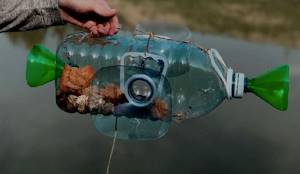
The fry are usually caught in the same body of water in which they plan to fish in the future. It is mined in two main ways:
- a light float fishing rod with thin equipment - a line no more than 0.12 mm thick, a light float with a weight of 0.5 grams, a thin leash with hook No. 18-20;
- whelp with a mesh mesh size of no more than 10 mm.
An alternative device for catching live bait can be a plastic bottle with holes made with an awl, in which the cut neck is inserted so that its wide part faces outward.
To catch live bait, a little bait or white bread crumb is poured inside such a device and, tied with a rope to a long stick, it is lowered horizontally to the bottom of the shallows. Live bait, attracted by bait or bread crumbs, willingly swims through the funnel neck inside the bottle, but cannot swim out.
Recommended reading: Fishing with a jig
Live bait bait methods
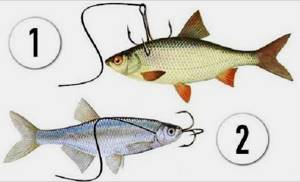
There are several ways to place live bait on a hook:
- Behind the back - with a hook they pierce the back of the fry, while trying not to damage its spine;
- Through the gills - the fishing line segment of the leash is passed through the gills of the fry and taken out of its mouth. After that, a double hook is tied, which is fixed in the mouth of the baitfish by pulling the leash in the opposite direction.
In some cases, the fry is simply caught by the lip. Pierce the upper or lower lip of the fish, bringing the sting of the hook out.
How to get live bait?
As previously noted, live bait must be in an active state when fishing. Otherwise, the pike perch will not respond to the bait.
You can get live bait as follows:
- You can catch it in a reservoir , where further fishing will also take place. This option is the best of all possible, since fishing in a reservoir will take place with live bait, to which the predator is accustomed.
- Many fishing stores also sell bait. When choosing it, it is worth considering the fact that it must be active. Its price is usually relatively low.
When preparing for fishing, you should take into account the fact that the bait should not die during transportation from home. To do this, you should prepare a special container with water, preferably not airtight. You can also use 5 liter bottles with small holes in the cap. Upon arrival at the reservoir, you should drain the water and then pour it from the reservoir , which will significantly extend the life of the bait and maintain its activity.
What gear is best for pike perch?
The choice of gear, as well as the choice of bait, should be given special attention.
Often used:
- A live bait is an ordinary fishing rod with a float; live bait is used instead of ordinary bait. They use similar gear for fishing from the shore while fishing in the current. You can also fish from a boat. This method is most effective when the day is clear during night fishing. Live bait makes it possible to fish hard-to-reach places that have complex bottom topography.
- The running bottom differs from the previous version in that it does not have a float; when rigging, a heavier weight is used. It can be used to fish large areas. A bite is signaled by the movement of the rod tip. Some fishermen attach a small bell to the fishing line, the ringing of which indicates a fish is biting.
- A donka with a rubber shock absorber involves the use of several leashes with different types of live bait. This method allows you to learn the taste preferences of predatory fish much faster. It is not recommended to cast bait as it may fly off. Therefore, fishing is often done from a boat.
- Zherlitsy can be used in any season as a slingshot or a stand with flags.
- Mugs are recommended for use in bodies of water without current.
- Using spinning fishing is no different from catching another predator. At the same time, we use live bait instead of spoons.
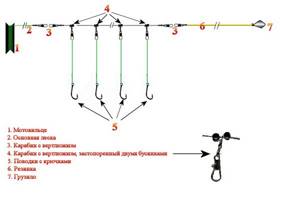
Donka with rubber shock absorber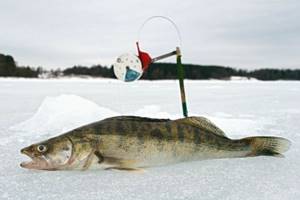
Zherlitsa
Circle
The type of gear used depends on the characteristics of the reservoir, the chosen time and place.
Advantages and disadvantages of the method
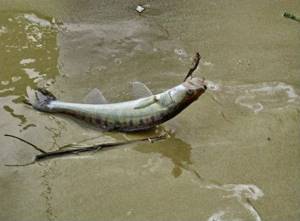
The main advantages of this fishing method are:
- Active and naturalistic movement in the water column of a fry mounted on a double or tee. No artificial bait can fully imitate the movements of a live fish.
- Cheapness and simplicity of the equipment used. For live bait fishing, you can use inexpensive rods, reels, simple but strong monofilament line or braided cord.
- Possibility of simultaneous use of several gears. Since live bait fishing is stationary, this allows you to use 2 or more gear at the same time. At the same time, a very large area of water is fished and the chance of catching fish increases.
- Stationarity and relatively low labor intensity. Live bait fishing, unlike fishing for pike perch with a spinning rod, does not involve frequent casting and retrieving. This makes this type of fishing less tiring and time-consuming, which many people like, especially older fishermen.
- High catchability. Using live bait allows you to catch pike perch not only during periods of high predator activity. There are situations when the use of various silicone baits or pike-perch wobblers does not produce results.
Disadvantages of fishing with live bait:
- Using sufficiently voluminous fishing equipment - a small fish, eland or other vessel for storing live bait;
- High cost of live bait in fishing stores;
- A long process of independent production of fry;
- During the fishing process, it is necessary to monitor the condition of the live bait - often change the water, throw out dead fish that have floated up with their bellies, place the kana with bait in a shady place not illuminated by the sun.
Recommended reading: Jig rig equipment
On a note ! Live bait fishing, unlike spinning, allows you to catch larger trophy pike perch. The weight of specimens caught with live bait reaches 5 kilograms or more, while 2-3 kilogram pike perch are usually caught with artificial bait.
Nuances of choosing hooks
The bait should not fly off during casting or biting. Therefore, it is recommended to use doubles No. 1-4 with a long forend.
You can purchase special doubles and trebles for live bait. Their peculiarity is that one hook is several times thinner than the others. When placing a fry on such a hook, it is less injured, which means it will be alive longer during fishing.
You can also use single hooks of appropriate sizes. A fishing line with a thickness of 0.25-0.30 is suitable.
Which hook is best to use for live bait fishing?
If you are not yet an experienced fisherman or have simply never fished with live bait, then a logical question will arise - which hook is better to use? After all, you can fish using a single hook, a double hook or a treble hook.
Here I have clear advice - to optimally use a double. The double incorporates the advantages of both the single hook and the treble hook. At the same time, it practically negates all their shortcomings.
The problem with a single hook is idle bites, since the fish can attack the bait from the wrong side or slightly past the hook. A tee solves this problem, but often a predator, having pricked itself on it, refuses to further attack the bait and does not bring the matter to a confident bite.
The double hook is at the same time not as rough as the treble hook and, at the same time, much more effective than the single hook. It is precisely based on these considerations that it is the best option. There are even special doubles, in which one hook is smaller and the other is larger - this is done so that the bait is less injured. As you might have guessed, the smaller hook is designed for baiting bait, and the larger one is for attacking predators.
Basic methods of baiting live bait
Taking into account certain recommendations for placing live bait on a hook will extend the life of the fry, which will have a good effect on the bite.
The main fishing methods include:
- When using a regular hook, the bait is hooked by hooking it on both lips or gills. This will ensure good attachment of the live bait to the hook.
- When using a double, you can attach live bait by the lip or back.
- When using a tee, you can also hook the fry on the back or lips.
The method of attaching the bait depends on the fishing location. When the current is strong , which is often the case when catching the predator in question, it is recommended to hook the fry by the gills or gills. If the current is not strong, you can hook the fry on its back.
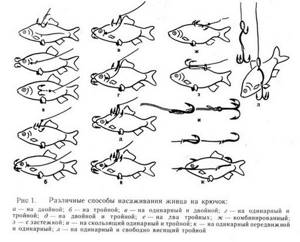
When using a jig as bait, it is recommended to attach the live bait to the lip. At the time of baiting, the bait should be calm, for which you can trim the tail fin.
Equipment tricks
For all methods of catching pike perch with live bait, the equipment required depends on the size of the expected prey. Therefore, if in a particular place of a reservoir or river the standard size of pike perch is 1-1.5 kg, then you should not use thick fishing line and huge hooks. For such fishing, a main line with a diameter of 0.3 mm is required, and leashes are made 30-50 cm long from 0.25 mm fishing line. Hooks should have a long shank, size No. 1-4. The weight of the sinker is selected depending on the strength of the current (so that it does not blow away from the fishing point) or on the mobility of live bait (in still water bodies). When shore fishing using a rod, it is important that the total weight of the sinker and live bait falls within the test range of the “stick”. And the length can be from 2.1 to 3.9 m. For fishing from a boat, the rod selected is short, up to 2.1 m.
Spinning fishing technique
There are a huge number of fishing techniques. The most famous is jig fishing.
The classical method can be characterized as follows:
- We carry out a long cast . It is important to cast far if the banks of the river are flat and the depth is far from the shore.
- After casting, you need to ensure that the line is constantly taut . If the tension at the tip has weakened, then the bait has reached the bottom.
- In the case under consideration, stepped wiring is used . To do this, make 2-3 turns with the reel and wait until the tension drops slightly and the bait falls to the bottom. We repeat the wiring process again.
- The pike perch can peck while retrieving, or at the moment of a temporary stop , when the bait sinks to the bottom. In this case, the hooking must certainly be sharp, since otherwise the long-awaited trophy during fishing may fall off the hook and go away.
- Fishing is recommended to be done using a friction clutch, as there will be a lot of jerking due to the aggressive behavior of the desired prey. The line must be kept taut at all times. If you do not monitor the tension of the fishing line, the fish will have enough freedom to jerk, and it will break off.
- When bringing out the pike perch, you can give it a breath of air .
At this point it will weaken, and prey can be taken by the gill covers. It is worth remembering that large individuals have fairly large teeth that resemble fangs.
The best live bait for catching predators
Since we have found out the best methods of baiting, information about which live bait is best suited for catching a predator will be no less interesting for you. Let's look into this interesting question.
Among the live baits suitable for catching predators are:
- crucian carp;
- perch;
- ruff;
- gudgeon;
- bleak;
- roach;
- pinching;
- minnow;
- rudd;
- loach.
Any of the listed fish will be a very effective live bait, just do not forget that pike perch, for example, prefers narrow-bodied fish due to the structure of its mouth. For pike perch, select live bait such as ruffe, gudgeon, bleak, spined lance, minnow, and loach. It is better to adhere to the same rule when catching perch.
Pike, catfish and burbot can attack both narrow-bodied and wide-bodied fish with equal success. The main thing is not to overdo it and understand that bream, for example, will not be a suitable candidate for the role of live bait due to its structure, because it will be difficult for a predator to swallow it.
You should also divide the fish into those that are tenacious and those that quickly become dead. Thus, live bait such as crucian carp, ruffe, and gudgeon will remain active for a long time. And bleak, roach, and rudd will quickly fall asleep.
Also, when choosing live bait for catching a predator, you must be guided by information about the main diet of the predator in a particular body of water. After all, if there is a lot of gudgeon in the reservoir and the predator is accustomed to feeding on it, then the gudgeon will bring maximum results in fishing. And if there is no gudgeon in a reservoir, then there is no point in catching it.
Your catch can tell a lot about a predator’s diet. When you cut it up, pay attention to the contents of the predator’s stomach. Usually the predator always has undigested fish left in its stomach. This way, you can determine what kind of fish the predator in the reservoir is used to eating and present it with just such live bait.
It is also important for fishing to use live bait from the same reservoir in which you plan to catch the predator. The behavior of a fish from another body of water, or, moreover, an artificially grown one, can differ radically from local live bait, which will alert the predator. As a result, the number of bites may be reduced.
Ruff, as a live bait, is good because the predator is aware that this prey will be prickly. This means that even if a predator gets pricked by the sting of a hook, it will not spit out its prey, as it will consider this to be a prick on the sharp spines of the ruff. Thus, the ruff helps to increase the percentage of successful strikes, since the predator is very good at swallowing such live bait, unaware of the danger.
That, in principle, is all the useful information that we wanted to convey to you. I hope all the information that ryba4ok.ru offered you in this article was interesting and useful for you. We are waiting for you on the pages of our website - no tail, no scales!
